 |
The Virginia Commonwealth University Jazz Orchestra I, performing under the direction of Antonio García, Director of Jazz Studies. |
|
This article is copyright 2019 by Antonio J. García and originally was published in Down Beat, Vol. 86, No. 12, December 2019. It is used by permission of the author and, as needed, the publication. Some text variations may occur between the print version and that below. All international rights remain reserved; it is not for further reproduction without written consent. |
Reharmonizing Melodies “On the Bus”
Masterclass
by Antonio J. García
 |
The Virginia Commonwealth University Jazz Orchestra I, performing under the direction of Antonio García, Director of Jazz Studies. |
There are infinite ways to reharmonize a melody when arranging a tune for an ensemble or your own solo performance. But what method can work for you, guaranteed, even if you’re on a bus to your next gig, without a keyboard or other chordal instrument, and facing a deadline to hand out your new chart on arrival? Here is a process that has never failed me; so I share it with my freshmen Jazz Theory students each year. It’s heavily rooted in lessons I learned from Ray Wright at The Eastman School of Music, both when I attended as a member of the Arranger’s Holiday summer program and then as a graduate student.
Most listeners are unaware that in a given sax soli, ensemble “shout” section, or in many solo performances on chordal instruments, there are times when every single note of a melodic line is harmonized by a different chord. This allows great harmonic color; and, if played by an ensemble, each musician receives a line to play that is much more interesting than repeating one chord-tone for an entire measure!
“On the Bus” Rules
To begin, have your chosen melody at hand, plus a chord in mind for at least the final note of the phrase (if not also all the chords typically associated with the tune). See the top line of Example 1 for our initial knowledge of the “original” melody harmony.
(Example 1 intentionally has no linked audio demo.)
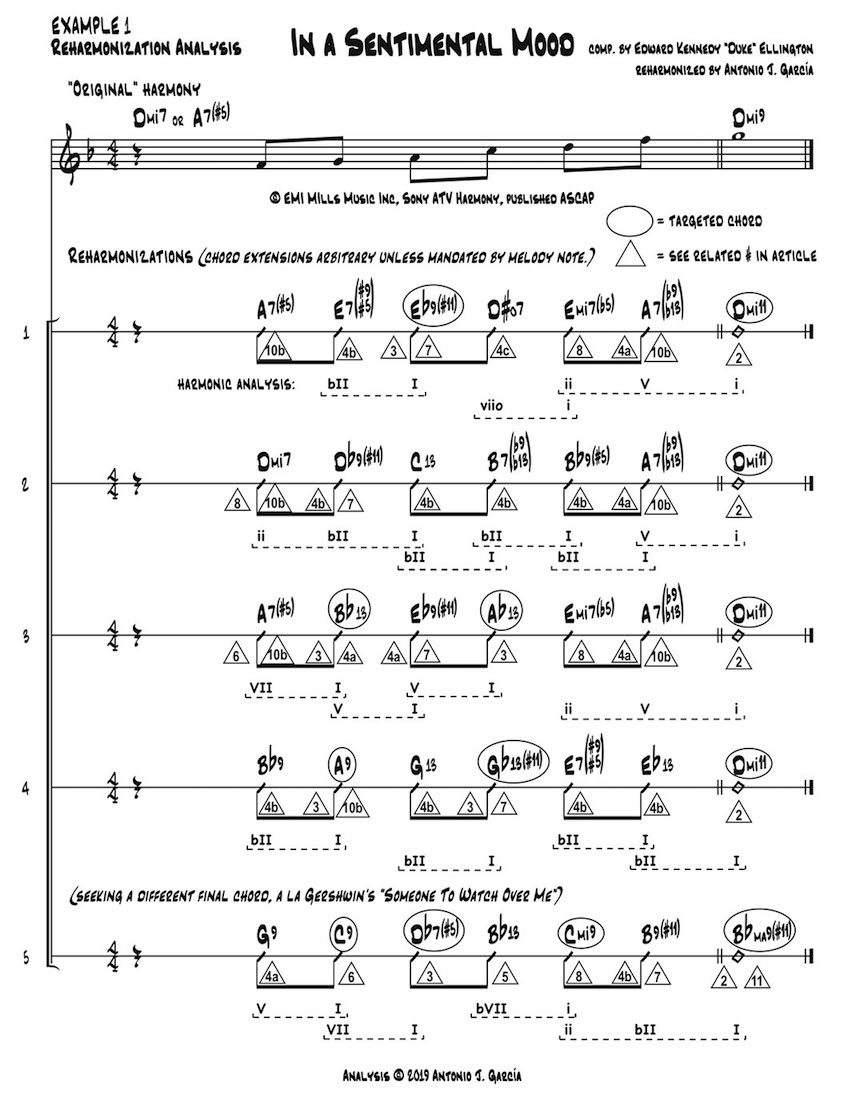 |
(Click here to download a printable PDF collection of all of the musical examples within this online article for your own ease of study off-line.)
In the example above, each of the five reharmonizations below the top line follow the process below:
1. Start at the end of a given phrase. If you start at the beginning, you never know where you’ll end up; but if you start at the end, you’ll have a targeted arrival that satisfies you!
2. Choose the chord for that final note. Whether major, minor, or other, that chord must be compatible with the melodic tone, as a primary tone or acceptable extension. The more similar to the original chord your choice is, the more traditional your harmonies will sound; the more radical your choice, the more radical your resulting progressions will sound! Circle that chord as your final target.
3. Look backwards over the melodic line and decide if there are other prominent notes that would be a worthy target as well. Perhaps they are notes emphasized by being high or accented and/or long. Circle those possible target-notes—unless you prefer none other than the final chord of the phrase.
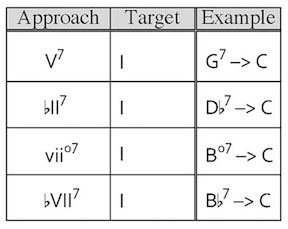 |
4. Now your job is to approach your final chord with strong harmonic movement. Consider it your temporary “tonic” chord. If viewed as your instant “I” chord, approach it by means as strong as Bach: by its (a) V7, (b) bII7 (“tritone substitution”), or (c) dim7 chord. The chord you choose must always be compatible with the melodic tone.
5. When seeking an approach-chord, note that suspended chords and major-seventh chords make poor approaches. In a typical environment, a sus chord wants to resolve its suspended-fourth to a third before moving on; and a major-seventh chord just wants to sit still. We want strong movement! And so if an approach by V7 or bII7 yields a suspended or major-seventh chord, invoke the “bVII bailout”: approach your target-chord instead by a dominant-seventh chord a full step below the target. I call this the “bailout” because in the freshman class I allow students to employ the bVII approach only when a V7 or bII7 yields a suspended or major-seventh chord.
6. An exception to the above major-seventh approach-chord issue is “planing.” I allow a limited amount of chromatic planing of any chord-quality. Examples might include Gbmaj7 –> Fmaj7 (as in the eighth and ninth bars of “The Girl from Ipanema”) or Bb7 –> B7 –> C7 (or Cm7). I also accept a limited amount of diatonic planing, such as Ebmaj7 –> Fm7 –> Gm7 (as in the opening of “They Can’t Take That Away From Me”). But if the goal is a sound more contemporary than the 1940s, the bulk of reharmonizations should be approaches by V7, bII7, or dim7.
7. If you find that your chosen chord’s root is actually in the melody and want more color than that, consider moving your root a tritone away.
8. You do have the option of editing a dominant-chord to become a minor-seventh (optional flat-five) chord as a pre-dominant passing chord within what becomes a ii-V or ii-bII progression.
9. Once you’ve chosen your approach chord to the final target, you’ve now reharmonized using our “on the bus” rules! Now it’s time to approach that approach. So now view your new approach- (penultimate) chord as your instant “I” (tonic) chord; and approach it by its V7, bII7, or dim7 chord. The chord you choose must always be compatible with the melodic tone, and be wary of suspended-fourth or major-seventh chords.
10. Continue this backwards-moving process until you arrive at a preceding target-note that you’ve circled. At this locale you can either choose to (a) harmonize it as an approach-chord as well to what follows; (b) use the chord originally appearing with the melody at that point so as to reinforce the traditional harmony of the melody; or (c) harmonize this note with any chord you enjoy—so long as the chord is compatible with the melodic note at that point. Note that if (b) or (c), your chord here may have nothing directionally to do with what follows; and that’s fine. Once Bach arrived at a targeted chord, his next harmony could go anywhere!
11. Approach this targeted chord using the “on the bus” rules cited above. (If your new chord was stunningly different than the original harmony, fine, so long as you approach it “legally.” The approach chords will emphasize your new harmonic direction.)
12. Continue this “tonicization” process backwards through the melodic line until reaching the beginning of your melodic phrase (for which you could again use the original harmony or continue the approach-chord process).
Reviewing Your Reharms
Reviewing Example 1, you’ll find that every chord in the five reharms is tagged with one or more triangled numbers that reference the steps above. So start at the end of a given chordal line in Example 1 above, and try to discover what process led to that chord-choice. Then cross-reference its number(s) to the list above for my rationale.
What if you’re not a strong pianist? You’ll find that aside from computerized playback, you can hear a lot about the quality of your reharmonization just by sitting at a keyboard, playing out of tempo the melody in your right hand and roots in your left (Example 2).
(Click each of the five numbered staves below to hear an mp3 audio demo of that reharmonization's bass line with the original melody. The top stave does not play.)
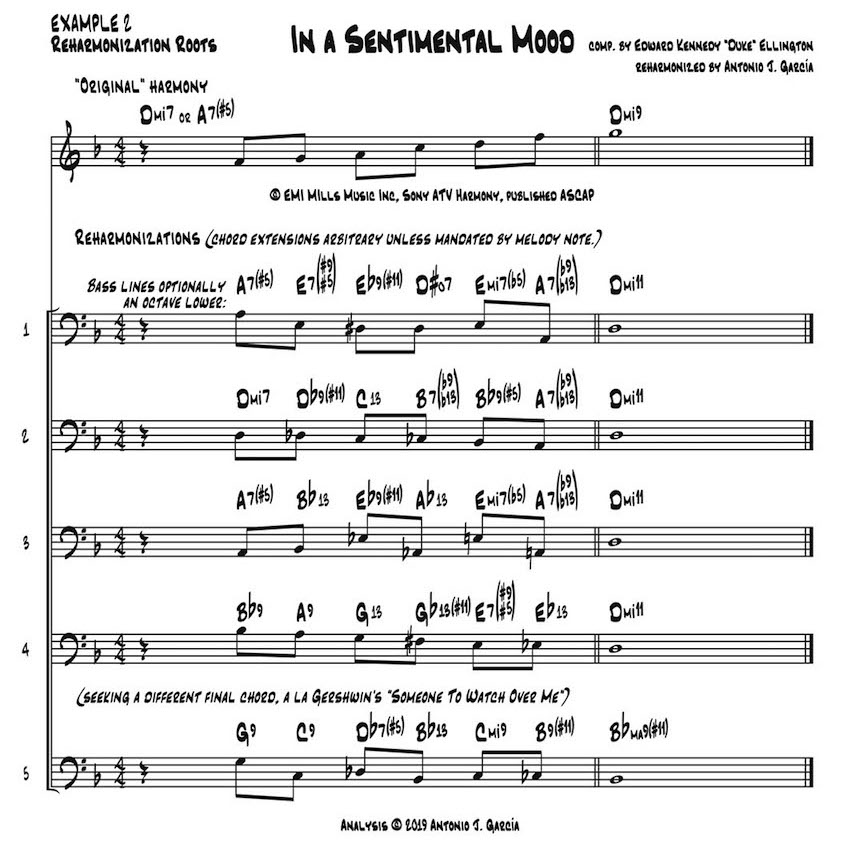 |
Or still with little piano chops, you can play root-and-seventh voicings in your left hand while playing the melody in the right or singing it (Example 3).
(Click each of the six grand staffs below to hear an mp3 audio demo of that harmony's root-seventh line with the original melody.)
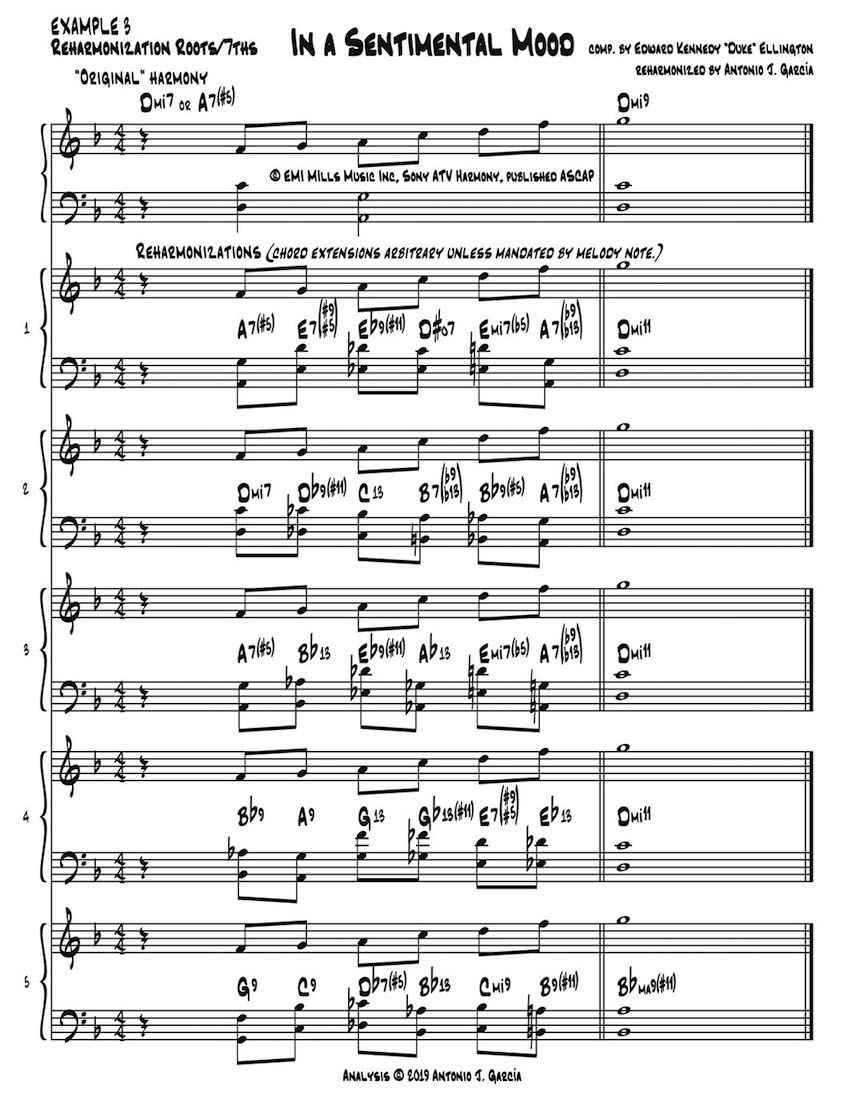 |
If you can play tones 1, 3, 5, and 7 in root position in the left and sing melody or play it in the right, then you’ll receive the aural information of Example 4.
(Click each of the six grand staffs below to hear an mp3 audio demo of that harmony's root-position seventh chord with the original melody.)
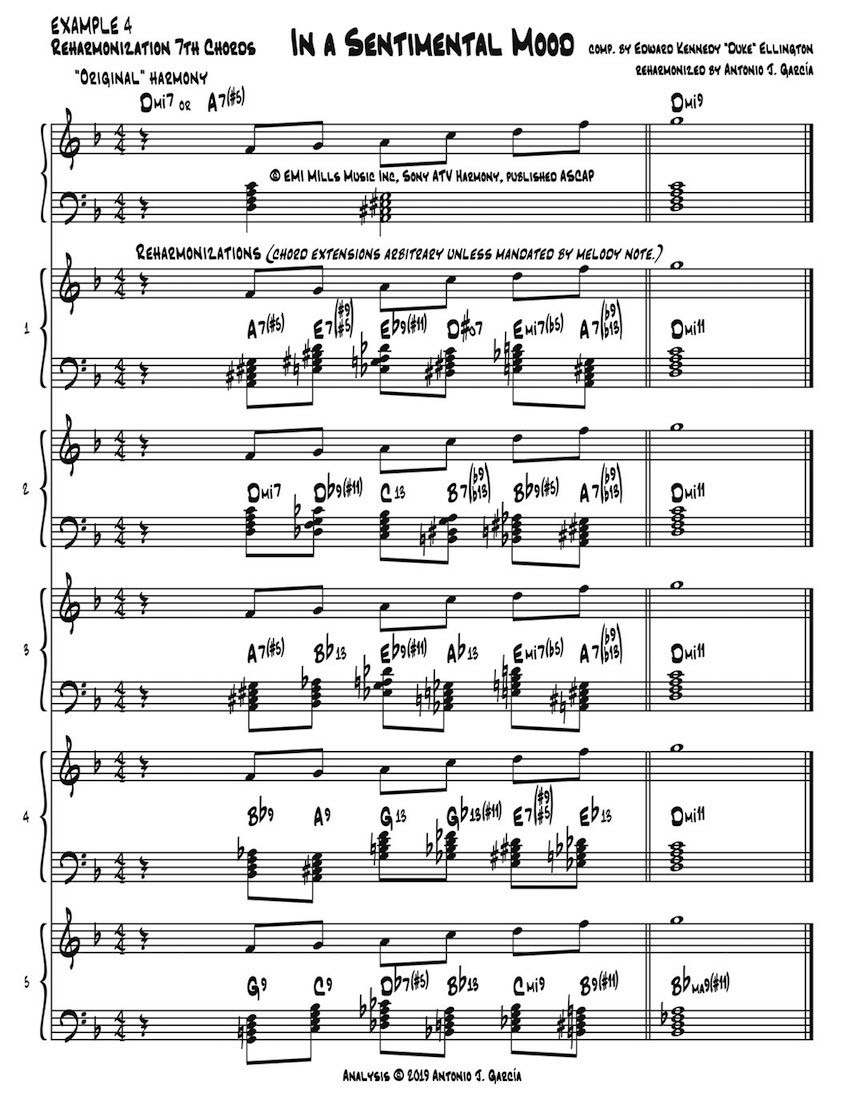 |
You’ll notice in the five sample reharmonizations I’ve provided that I tend to favor seventh-chords rather than sixth-chords, dominant-chords instead of diminished chords, and avoid roots above the bass. I generally prefer more “bite” in my harmonies. If you wish to avoid repeated pitches, a slight change in color-tone or chord will provide options.
Of course, you can take any reharmonization and personalize it further with ingredients that don’t follow these concepts: linear writing, chromatic inflections, random notes, and more. It’s simply about how much red you want in your painting—or spice in your cooking. You can’t establish rules for musical taste. But you likely also won’t be as confident that the writing you did on the bus will work when you walk off of it. If you follow and develop your skill within the “bus rules,” you’ll find that you have myriad options available to you while still ensuring the sonic quality of your work.
Applying Your Reharms
If you later want to voice out your new harmonies for an ensemble, consider including a third, seventh, and then color tones within each voicing, as evidenced in the combo voicings of Examples 5-9. Each example includes at the bottom a grand-staff reduction of the voicings and bass line.
(Click on each Example number below to hear an mp3 audio demo of that harmony's combo-voicing with the original melody.)
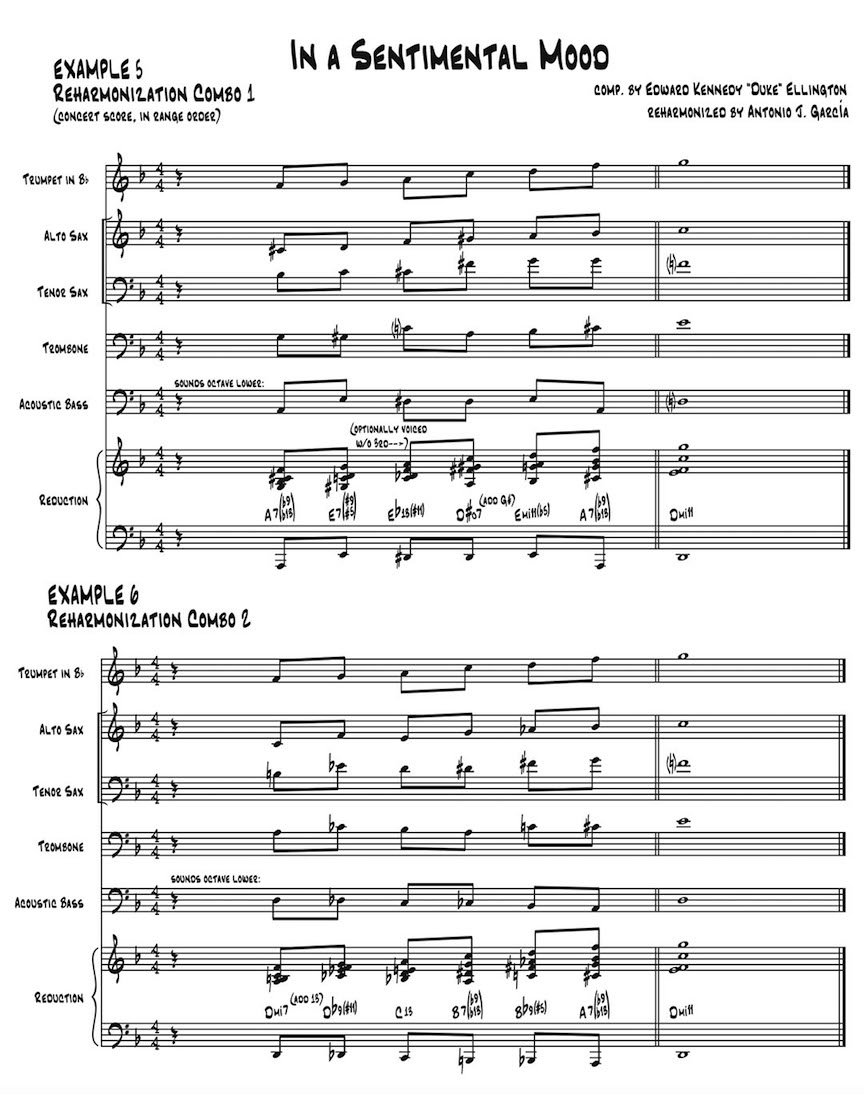 |
 |
If you voice a “shout”-style section for big band, include those very tones within the trumpet section, perhaps doubled an octave down within the trombones and saxes (range-permitting) to attain just one style of scoring. For online readers, I’ve created five additional notated examples not found in the printed article: here I’ve scored these reharmonizations for big band in a traditional manner—still utilizing the five reharmonizations already demonstrated.
(Click anywhere within a given two-bar Example below to hear an mp3 audio demo of that harmony's big-band-voicing with the original melody. And if you have not yet downloaded the printable PDF collection of all of the musical examples within this online article for your own ease of study off-line, you may now find it particularly useful instead of eyeing the smaller notation below. Click here to download the printable PDF collection.)
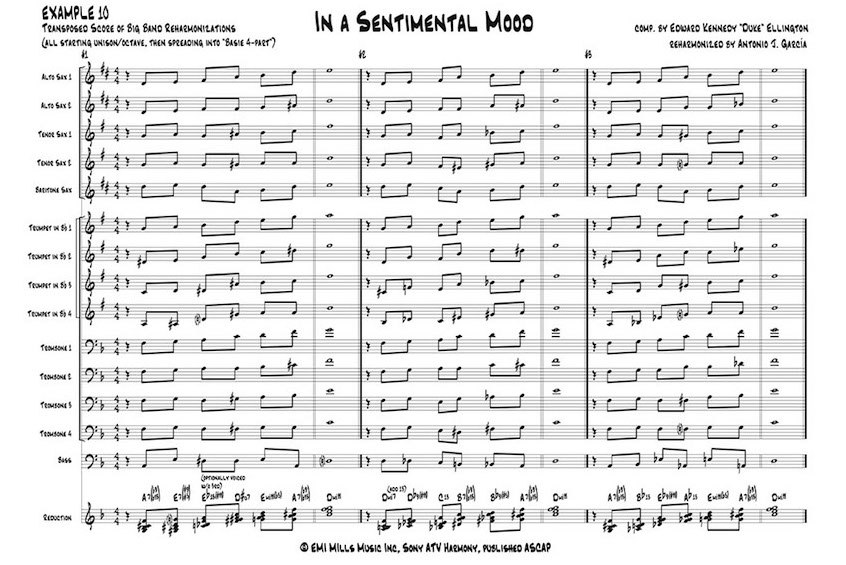 |
 |
Over the past several decades of writing, I’ve enjoyed reharmonizing and scoring using a number of non-traditional and even random techniques. I’m not interested in stifling my options or those of my students: we should all explore our individuality! But when I look for a solid solution yielding strong harmonic movement, I still often turn to “the bus”: it’s a most useful tool to have in my box.
Regarding arranging, Ray Wright once told me in a lesson: “There’s always a solution.” I highly recommend his book Inside the Score (Kendor), in which he explores eight band charts by Sammy Nestico, Thad Jones, and Bob Brookmeyer and illuminates how well the above reharmonization techniques and others have served those legendary composers/arrangers. For a contrasting, linear, and equally valid approach to ensemble-writing, check out the superb Jazz Arranging and Composing: A Linear Approach (Advance Music) by my Eastman writing-mentor, Bill Dobbins. Both he and Ray taught my undergraduate arranging teacher at Loyola University in New Orleans, John Mahoney; I was most fortunate to have studied writing under all three. Some of Ray’s and Bill’s students have now in turn written superb books analyzing the scores of contemporary arranging masters; check them out!
_ _ _ _ _ _ _ _ _ _ _ _ _ _ _
Antonio J. García is a Professor Emeritus and former Director of Jazz Studies at Virginia Commonwealth University, where he directed the Jazz Orchestra I; instructed Applied Jazz Trombone, Small Jazz Ensemble, Jazz Pedagogy, Music Industry, and various jazz courses; founded a B.A. Music Business Emphasis (for which he initially served as Coordinator); and directed the Greater Richmond High School Jazz Band. An alumnus of the Eastman School of Music and of Loyola University of the South, he has received commissions for jazz, symphonic, chamber, film, and solo works—instrumental and vocal—including grants from Meet The Composer, The Commission Project, The Thelonious Monk Institute, and regional arts councils. His music has aired internationally and has been performed by such artists as Sheila Jordan, Arturo Sandoval, Jim Pugh, Denis DiBlasio, James Moody, and Nick Brignola. Composition/arrangement honors include IAJE (jazz band), ASCAP (orchestral), and Billboard Magazine (pop songwriting). His works have been published by Kjos Music, Hal Leonard, Kendor Music, Doug Beach Music, ejazzlines, Walrus, UNC Jazz Press, Three-Two Music Publications, Potenza Music, and his own garciamusic.com, with five recorded on CDs by Rob Parton’s JazzTech Big Band (Sea Breeze and ROPA JAZZ). His scores for independent films have screened across the U.S. and in Italy, Macedonia, Uganda, Australia, Colombia, India, Germany, Brazil, Hong Kong, Mexico, Israel, Taiwan, and the United Kingdom. He has fundraised $5.5 million in external gift pledges for the VCU Jazz Program, with hundreds of thousands of dollars already in hand.
A Bach/Selmer trombone clinician, Mr. García serves as the jazz clinician for The Conn-Selmer Institute. He has freelanced as trombonist, bass trombonist, or pianist with over 70 nationally renowned artists, including Ella Fitzgerald, George Shearing, Mel Tormé, Doc Severinsen, Louie Bellson, Dave Brubeck, and Phil Collins—and has performed at the Montreux, Nice, North Sea, Pori (Finland), New Orleans, and Chicago Jazz Festivals. He has produced recordings or broadcasts of such artists as Wynton Marsalis, Jim Pugh, Dave Taylor, Susannah McCorkle, Sir Roland Hanna, and the JazzTech Big Band and is the bass trombonist on Phil Collins’ CD “A Hot Night in Paris” (Atlantic) and DVD “Phil Collins: Finally...The First Farewell Tour” (Warner Music). An avid scat-singer, he has performed vocally with jazz bands, jazz choirs, and computer-generated sounds. He is also a member of the National Academy of Recording Arts & Sciences (NARAS). A New Orleans native, he also performed there with such local artists as Pete Fountain, Ronnie Kole, Irma Thomas, and Al Hirt.
Mr. García is a Research Faculty member at The University of KwaZulu-Natal (Durban, South Africa) and the Associate Jazz Editor of the International Trombone Association Journal. He has served as a Network Expert (for Improvisation Materials), President’s Advisory Council member, and Editorial Advisory Board member for the Jazz Education Network . His newest book, Jazz Improvisation: Practical Approaches to Grading (Meredith Music), explores avenues for creating structures that correspond to course objectives. His book Cutting the Changes: Jazz Improvisation via Key Centers (Kjos Music) offers musicians of all ages the opportunity to improvise over standard tunes using just their major scales. He is Co-Editor and Contributing Author of Teaching Jazz: A Course of Study (published by NAfME), authored a chapter within Rehearsing The Jazz Band and The Jazzer’s Cookbook (published by Meredith Music), and contributed to Peter Erskine and Dave Black’s The Musician's Lifeline (Alfred). Within the International Association for Jazz Education he served as Editor of the Jazz Education Journal, President of IAJE-IL, International Co-Chair for Curriculum and for Vocal/Instrumental Integration, and Chicago Host Coordinator for the 1997 Conference. He served on the Illinois Coalition for Music Education coordinating committee, worked with the Illinois and Chicago Public Schools to develop standards for multi-cultural music education, and received a curricular grant from the Council for Basic Education. He has also served as Director of IMEA’s All-State Jazz Choir and Combo and of similar ensembles outside of Illinois. He is the only individual to have directed all three genres of Illinois All-State jazz ensembles—combo, vocal jazz choir, and big band—and is the recipient of the Illinois Music Educators Association’s 2001 Distinguished Service Award.
Regarding Jazz Improvisation: Practical Approaches to Grading, Darius Brubeck says, "How one grades turns out to be a contentious philosophical problem with a surprisingly wide spectrum of responses. García has produced a lucidly written, probing, analytical, and ultimately practical resource for professional jazz educators, replete with valuable ideas, advice, and copious references." Jamey Aebersold offers, "This book should be mandatory reading for all graduating music ed students." Janis Stockhouse states, "Groundbreaking. The comprehensive amount of material García has gathered from leaders in jazz education is impressive in itself. Plus, the veteran educator then presents his own synthesis of the material into a method of teaching and evaluating jazz improvisation that is fresh, practical, and inspiring!" And Dr. Ron McCurdy suggests, "This method will aid in the quality of teaching and learning of jazz improvisation worldwide."
About Cutting the Changes, saxophonist David Liebman states, “This book is perfect for the beginning to intermediate improviser who may be daunted by the multitude of chord changes found in most standard material. Here is a path through the technical chord-change jungle.” Says vocalist Sunny Wilkinson, “The concept is simple, the explanation detailed, the rewards immediate. It’s very singer-friendly.” Adds jazz-education legend Jamey Aebersold, “Tony’s wealth of jazz knowledge allows you to understand and apply his concepts without having to know a lot of theory and harmony. Cutting the Changes allows music educators to present jazz improvisation to many students who would normally be scared of trying.”
Of his jazz curricular work, Standard of Excellence states: “Antonio García has developed a series of Scope and Sequence of Instruction charts to provide a structure that will ensure academic integrity in jazz education.” Wynton Marsalis emphasizes: “Eight key categories meet the challenge of teaching what is historically an oral and aural tradition. All are important ingredients in the recipe.” The Chicago Tribune has highlighted García’s “splendid solos...virtuosity and musicianship...ingenious scoring...shrewd arrangements...exotic orchestral colors, witty riffs, and gloriously uninhibited splashes of dissonance...translucent textures and elegant voicing” and cited him as “a nationally noted jazz artist/educator...one of the most prominent young music educators in the country.” Down Beat has recognized his “knowing solo work on trombone” and “first-class writing of special interest.” The Jazz Report has written about the “talented trombonist,” and Cadence noted his “hauntingly lovely” composing as well as CD production “recommended without any qualifications whatsoever.” Phil Collins has said simply, “He can be in my band whenever he wants.” García is also the subject of an extensive interview within Bonanza: Insights and Wisdom from Professional Jazz Trombonists (Advance Music), profiled along with such artists as Bill Watrous, Mike Davis, Bill Reichenbach, Wayne Andre, John Fedchock, Conrad Herwig, Steve Turre, Jim Pugh, and Ed Neumeister.
The Secretary of the Board of The Midwest Clinic and a past Advisory Board member of the Brubeck Institute, Mr. García has adjudicated festivals and presented clinics in Canada, Europe, Australia, The Middle East, and South Africa, including creativity workshops for Motorola, Inc.’s international management executives. The partnership he created between VCU Jazz and the Centre for Jazz and Popular Music at the University of KwaZulu-Natal merited the 2013 VCU Community Engagement Award for Research. He has served as adjudicator for the International Trombone Association’s Frank Rosolino, Carl Fontana, and Rath Jazz Trombone Scholarship competitions and the Kai Winding Jazz Trombone Ensemble competition and has been asked to serve on Arts Midwest’s “Midwest Jazz Masters” panel and the Virginia Commission for the Arts “Artist Fellowship in Music Composition” panel. He was published within the inaugural edition of Jazz Education in Research and Practice and has been repeatedly published in Down Beat; JAZZed; Jazz Improv; Music, Inc.; The International Musician; The Instrumentalist; and the journals of NAfME, IAJE, ITA, American Orff-Schulwerk Association, Percussive Arts Society, Arts Midwest, Illinois Music Educators Association, and Illinois Association of School Boards. Previous to VCU, he served as Associate Professor and Coordinator of Combos at Northwestern University, where he taught jazz and integrated arts, was Jazz Coordinator for the National High School Music Institute, and for four years directed the Vocal Jazz Ensemble. Formerly the Coordinator of Jazz Studies at Northern Illinois University, he was selected by students and faculty there as the recipient of a 1992 “Excellence in Undergraduate Teaching” award and nominated as its candidate for 1992 CASE “U.S. Professor of the Year” (one of 434 nationwide). He is recipient of the VCU School of the Artsí 2015 Faculty Award of Excellence for his teaching, research, and service and in 2021 was inducted into the Conn-Selmer Institute Hall of Fame. Visit his web site at <www.garciamusic.com>.
If you entered this page via a
search engine and would like to visit more of this site,